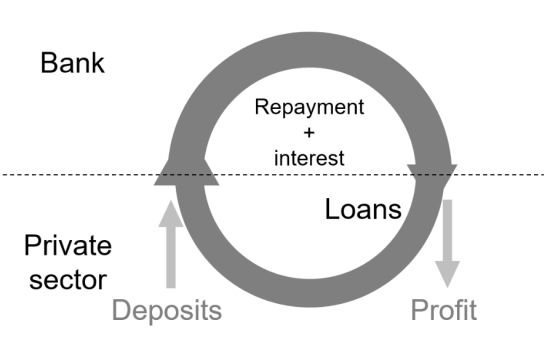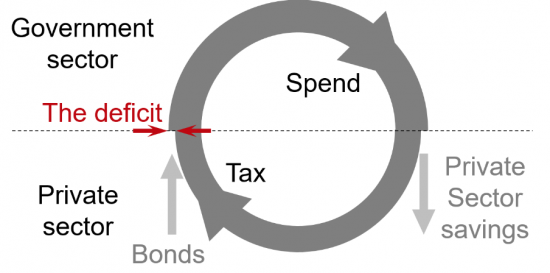銀行および金融機関のポートフォリォ選好が,相異なるタイプの資本資産に対する資本化率と, さまざまな投資に対する融資条件とを決定する。われわれの世界は,異質な資本資産,大がかりな金融を必要とする生産技術,おょび事業と金融にかんする多様な組織形態とによって特徴づけられている.このような世界では,金融上の有利あるいは不利が,生産における有利,不利を相殺することもありうる。つまり生産技術の_Lで成功したとしても,それが金融面における有利さを大きく相殺してしまうのであれば,そのような成功は技術的に劣勢になりうる。われわれの経済を理解するには,批判的で,謹直な観察を銀行機能に向ける必要がある。経済の不安定性を誘発し増幅させるものは,ある崩壊的な力である。たとえそれが,投資および経済成長の金融にとって本質的な要因であるとしても.銀行事業銀行業とは,貨幣貸付ではない。貸付を行うためには,貸し手は貨幣をもっていなければならない。基本的な銀行活動とは,ある者が信用するに足るということを受諾する,つまり保証することである.債務証書を受領することによって,銀行は債務者の意思・能力にかかわらず特定された支払をなすことに同意するのである。 このように銀行によって`受領ないしは裏書された手形は,その後公開市場で販売されるようになる.銀行貸付とは,銀行が受諾した手形を銀イ千/_ヾ購買することに等しい。
___
出典不明
But most important, Marx’s law of profitability is not just a secular or long-term gradual thing that has no relevance to the cycle of crises in capitalism. The law is both secular and cyclical. When profitability falls to such a point that the mass of profit and even total new value stops rising, a collapse in investment and output ensues. When capital has been reduced (closures, mergers, layoff of labour) sufficiently to restore profitability, then production recovers and the whole cycle begins again. This is the cycle of profitability that explains regular booms and slumps in modern capitalist economies.

Capitalism is a profit-making economy so it is profit and profitability that decides investment, then output and employment. The Keynesians say it is the other way round; investment leads profits. But this is back to front. In my presentation, I offered causal empirical evidence (not just correlations) that profits lead investment, not vice versa.
MMT: economics for an economy focussed on meeting the needs of most people
Cambridge Journal of Economics 2001, 25, 149-163
The role of the state and the hierarchy of money
Stephanie Bell*
横川論考
Minsky, H. P.(1982)Can “it” Happen Again?, M. E. Sharp.(岩佐代市訳『投資と金融』日本経済評論社,2003年。)
ーー(1986)Stabilizing an unstable economy, New Haven: Yale University Press.(吉野紀・浅田統一郎・内 田和男訳『金融不安定性の経済学:歴史・理論・政策』多賀出版,1989年。)
信用収縮
一般的に信用収縮は、"膨らみ過ぎた"資産の市場価格下落と価格崩壊による金融危機によって生じる[7]。その結果、膨れ上がった資産価格が急激に下落し、投資家や市場に遅れて参入した起業家への幅広い差押えや倒産が起こる。対照的に流動性危機(liquidity crisis)は、健全な事業に対して、事業拡大またはキャッシュフロー支払いを円滑化するために必要なつなぎ融資(ブリッジ・ファイナンス、bridge finance)が一時的に実行できない場合に発生する。この場合、追加信用取引により、企業による問題への対処と支払いおよび事業の継続が可能になる。危機の最中には、問題を抱える事業が支払い危機の状態にあるのか、それとも一時的な流動性危機の状態にあるのか、判断することは難しい。
信用収縮が発生した場合、"値洗い"(mark to market、時価評価損益の計算)を行うことが望まれる。そして影響を受けた事業の金融資本が信用循環の後退フェーズを生き残るために不十分な場合、その事業は売却または清算される。他方、流動性危機の場合は、追加信用取引を求めることが望まれる。一旦流動性危機が克服されると成長のための機会が期待できる。
長期の信用収縮は、安易で潤沢な融資("あぶく銭"あるいは"信用喪失")とは対極にある。信用循環が上昇フェーズの間は、資産価格の激しい値付け競争、借入金をてこにした入札、特定の資産市場におけるインフレーションなどが生じる。その結果、投機価格"バブル"が発生する。これがまた通貨供給量(money supply)を拡大、経済活動を刺激し、経済成長と雇用の一時的な上昇をもたらす[8][9]。
関係者にとってバブルがいつ崩壊したかは、後から振り返った時にのみ分かる。経済バブルは、ポンジ・スキーム(Ponzi scheme)や無限連鎖講(ピラミッドスキーム、Pyramid scheme)のようではない、ダイナミックな特徴を持っている[10]。
世界恐慌最中の1931年、ケインズは次のように述べている。「悲しいかな、健全な銀行家とは、危険を予測してそれを回避する人ではなく、破産した時に誰も自分を非難できないように、仲間と一緒にありきたりの方法で破産する人のことだ。」[11]
☆☆
Minsky, 1986; Foley, 1987; Wray, 1990) have recognised as a debt-pyramid or ' ... are positioned higher than others. ... the Currency and Banking Schools serving as the primary participants, and have ...
Cambridge Journal of Economics 2001, 25, 149-163
The role of the state and the hierarchy of money
Stephanie Bell*
Minsky's definition of money as a two-sided balance sheet phenom
on the nature, evolution and role of
opposing theories in the history of monetary
This paper uses
enon to challenge many common positions
money. His definition is applied to two
debates, and it is shown that the Chartalists (as opposed to the Metallists) developed
a general theory of money that can be applied equally convincingly to the entire era of
state money. This theory is then used to show that the state's power to make and
enforce tax laws renders its money the most acceptable form of debt within what can
be considered a 'hierarchy' of monies. This leads to some
tions as well as a
important policy implica
strengthening of the endogenous money position
Key words: Money, Taxes, Chartalist, Metallist, Monetary theory
JEL classifications: B25, E42, E62
1. Introduction
The purpose of this essay is to analyse more thoroughly what several economists (e.g.,
Minsky, 1986; Foley, 1987; Wray, 1990) have recognised
of money', which exists in all modern economies. Because a theory of money is the foun-
dation for an analysis of the 'hierarchy', the paper begins with a definition and discussion
of the manner in which money will be treated in the essay. This definition is then applied
to an analysis of two opposing theories of money, the Metallist and Anti-metallist (or
Chartalist), in order to determine which conforms to the requisite definition of money.
a debt-pyramid or 'hierarchy
as
The most
compatible theory is then used to describe the structure and composition of the
hierarchy. Specifically, the Chartalist theory is used to explain why the various monies are
denominated in a particular unit of account and why certain monies within the hierarchy
are positioned higher than others
The positioning of the state's money at the top of the pyramid implies
lationship between 'the fiscal, tax-raising, authority
on the other (Goodhart, 1997, p. 1). This relationship, when maintained, enables (or, at
an intimate re-
on the one hand and money creation
Manuscript received 23 March 1998; final version received 30 July 1999
Address for correspondence: Stephanie Bell, University of Missouri-Kansas City, Department of Economics,
211 Haag Hall, 5100 Rockhill Road, Kansas City, MO 64110, USA; email BellSA@umkc.edu
*University of Missouri-Kansas City. This paper was written while the author was Cambridge University
Visiting Scholar at the Jerome Levy Economics Institute and was
Eastern Economic Association in New York City. The author would like to
from The Center for Full Employment and Price Stability and to thank John Henry, Jan Kregel, James Tobin,
Douglas Vickers, L. Randall Wray and two anonymous referees for helping
developed in the paper. None, of course, is responsible for what follows
presented
at the 1998 meetings of the
acknowledge financial support
improve the arguments
to
O Cambridge Political Economy Society 2001
Minsky 1986 sta un money
Foley
ケンブリッジジャーナルオブエコノミクス2001、25、149-163
国家の役割と
お金
ステファニーベル*
両面バランスシート表現としてのミンスキーの貨幣の定義
の性質、進化および役割
貨幣史における反対論
この論文は
多くの一般的な立場に挑戦するためのエノン
お金。彼の定義は二つに当てはまる
そして、それはチャートリストが(メタリストとは対照的に)発展したことを示しています。
の時代全体に等しく説得力を持って適用することができるお金の一般理論
州のお金この理論は、国家の権力が
税法を執行することで、可能な範囲内で、その資金が最も許容可能な形態の債務となる。
お金の「階層」と見なされます。これはいくつかにつながります
と同様に
重要な政策の意味
内生的な資金ポジションの強化
キーワード:お金、税金、チャートリスト、メタリスト、貨幣理論
JELの分類:B25、E42、E62
はじめに
このエッセイの目的は、何人かのエコノミストがより徹底的に分析することです。
ミンスキー、1986年。フォーリー、1987年。 1990年のWray
これは現代のすべての経済に存在します。お金の理論が創始者だから
「階層」の分析のために、この論文は定義と議論から始まります。
エッセイでお金が扱われる方法の。この定義が適用されます
対立する2つの貨幣理論、メタリストとアンチメタリスト(または
Chartalist)、どちらが必要なお金の定義に準拠しているかを判断するため。
負債ピラミッドまたは「階層」
として
一番
互換性のある理論はそれからの構造そして構成を記述するのに使用されている
階層。具体的には、Chartalist理論は、さまざまな金銭がなぜあるのかを説明するために使用されます。
特定の会計単位で表示され、その階層内の特定の金額
他より高い位置にある
国のお金をピラミッドの一番上に配置することは、暗黙のうちに
財政、増税、権威間の関係
他方では(Goodhart、1997、p。1)。この関係は、維持されると可能になります(または、
親密な再
一方ではお金の創造
原稿は1998年3月23日に受け取りました。 1999年7月30日に受信した最終版
連絡先住所:ミズーリ州カンザスシティ大学ステファニーベル経済学部
211 Haag Hall、5100 Rockhill Road、カンザスシティ、MO 64110、米国; BellSA@umkc.eduに電子メールを送りなさい
*ミズーリ大学カンザスシティ校。この論文は著者がケンブリッジ大学である間に書かれました
Jerome Levy Economics Instituteの奨学金を受けて
ニューヨーク市東部経済協会。作者は
「完全雇用と物価安定のためのセンター」より、John Henry、Jan Kregel、James Tobinに感謝します。
Douglas Vickers、L. Randall Wray、そして2人の匿名のレフェリーが協力しています
論文で開発された。もちろん、それに続くものに対して責任を負うものは誰もいません。
提示された
1998年の会議で
財政支援を認める
引数を改善する
に
ケンブリッジ政治経済協会2001
Foley (1987 Foley, D. 1987. “Money in Economic Activity .” In The New Palgrave: Money, edited by J. Eatwell, M. Milgate, and P. Newman, 519–525. New York, NY: W.W. Norton.
THE HIERARCHY OF MONEY by Stephanie Bell Visiting Scholar, The Jerome Levy Economics Institute April 1998
^
Foley, Duncan. 1989. "Money in Economic Activity." The New Palgrave: Money , edited by John Eatwell, Murray Milgate, and Peter Newman. New York and London: W.W. Norton, pp. 519-525.
^
Minsky, Hyman P. 1986. Stabilizing An Unstable Economy , New Haven: Yale University Press.
☆
…
But this means that the Bank of England really should be saying that the third type of money is government created, because it is. Modern monetary theory is explicit about that. MMT recognises that both government created and bank created money exist. Here I will borrow from another post by Charles Adam on Progressive Pulse. As he says:
Money is created either when the government spends, or when a bank makes a loan. We can think of government spending and bank loans as the beginning of two interconnected money circuits. The government and bank circuits form the duopoly of money creation.
The Bank of England acknowledges the bank money circuit, which Charles draws as follows:
The bank lends money into existence. That creates private debt that is cancelled on repayment. I stress the point: repayment of loans does not provide new money for lending. It just cancels debt.
The money lent does not exist before it is lent. It is created by double-entry book-keeping and not by a printing press. Simply recording the debt in the books of the bank and customer creates the money because that is what is required to record the promise which gives fiat money its value. And repaying it reverse the entry and cancels the money. The promise has been fulfilled and is at an end.
And that's it, although interest does create another circuit, part of which leaks into bank profit. But the point is that there is public debt until the loan is repaid matched by public wealth - the deposits held at banks created by the people who receive the lent funds when they are spent by the borrower.
The government circuit is actually remarkably similar to this, and the logic is identical. This is the diagram:
Just as a bank does not wait for someone to deposit money to lend (and could not in the first instance, because until banks lent there would be no money to deposit) so governments don't wait to collect tax before they spend. Instead they tell their own bank (the Bank of England in the UK) to spend for them. And then when they have spent they have created the money that can be paid in tax. And they have also created the money that can be used to buy the bonds the government issues if tax receipts are less than the total spend.
しかしこれは、イングランド銀行が本当に第三の種類のお金は政府が創ったものであると言っているべきだということを意味します。現代の貨幣理論はそれについて明白です。 MMTは、政府が創設したお金と銀行が創設したお金の両方が存在することを認識しています。ここで私はプログレッシブパルスに関するチャールズアダムによる別の記事から借りるつもりです。彼が言うように:
お金は、政府が支出したとき、または銀行が融資したときに作成されます。政府支出と銀行ローンは、相互に関連する2つのマネーサーキットの始まりと考えることができます。政府と銀行の回路が貨幣創造の複占を形成しています。
イングランド銀行は、チャールズが次のように描いている銀行マネーサーキットを認めています。
銀行はお金をかけて存在させる。それは返済時にキャンセルされる民間債務を作成します。私はその点を強調しています。ローンの返済は、融資に新しい資金を提供するものではありません。借金を解消するだけです。
貸したお金は貸し出す前には存在しません。印刷機ではなく複式記帳で作成されています。銀行と顧客の帳簿に負債を記録するだけでお金が生まれます。それが、フィアットお金に価値を与える約束を記録するために必要なことです。そして、それを返済することはエントリーを逆転させ、そしてお金をキャンセルします。約束は果たされてきて、終わりです。
そしてそれはそれです、興味は別の回路を作成しますが、その一部は銀行の利益に漏れます。しかし重要なのは、融資が返済されるまでの間に公的資産 - 借り手が借りた資金を受け取った人が銀行に預けた預金 - が返済されるまでは公的債務があるということです。
政府の回路は実際にはこれと非常によく似ており、論理も同じです。これがダイアグラムです:
銀行が誰かが貸すためにお金を預けるのを待たないのと同じように(そして最初の例では、銀行が貸すまではお金を払うことができないので)、政府は彼らが使う前に税金を集めるのを待ちません。代わりに、彼らは自分たちの銀行(イギリスのイングランド銀行)に彼らに支出するように言います。そして、彼らが過ごしたとき、彼らは税金で支払われることができるお金を生み出しました。そして、彼らはまた、納税額が総支出額よりも少ない場合に政府が発行する債券を購入するために使用できる資金を生み出しました。





0 Comments:
コメントを投稿
<< Home